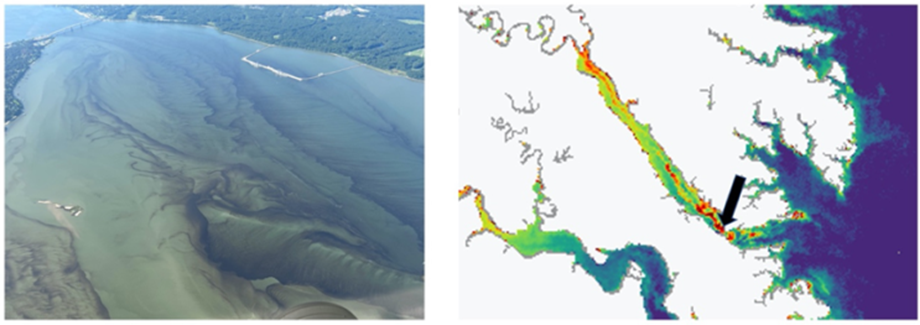This project will pilot a regional monitoring and response network for the lower Chesapeake Bay that incorporates a diverse suite of existing and new field and experimental measurements. It will expand our understanding of the geographic and temporal distribution of harmful algal bloom (HAB) species throughout the bay and inform predictive models that will enable the delivery of HAB forecasts to inform decisions by shellfish growers, state and regional managers, and other stakeholders.
Why We Care
In the Chesapeake Bay and mid-Atlantic region, late summer blooms of Margalefidinium polykrikoides have occurred nearly annually for decades. Since 2007, M. polykrikoides blooms have been followed by blooms of Alexandrium monilatum. Annual blooms of these harmful algal species have been linked to shellfish and fish kills, eutrophication and regional hypoxia/anoxia. These HABs disrupt oyster aquaculture and bay restoration, degrade coastal ecosystem quality, and can impact tourism and recreation.
Previous research efforts identified bloom initiation hotspots, bloom transport pathways, and models describing bloom development and transport were developed. Also project partners had established several bloom monitoring and tracking networks using fixed sampling stations, small boat-based surface water sampling, and satellite surveillance. The current project will integrate and enhance these regional capabilities with the addition of phytoplankton imaging data through deployments of the cutting-edge PlanktoScope (a high-resolution, low cost digital microscope) with team members and stakeholders to pilot a HAB observing network.

What We Are Doing
The project team is leveraging existing HAB surveillance networks that include daily to sub-daily sampling at fixed sites in the York and lower James River, weekly boat sampling during DataFlow cruises, and weekly to monthly sampling at shellfish growing areas. The team will train a cadre of users to enhance these HAB surveillance efforts with microscopic phytoplankton images generated by PlanktoScope. The team will conduct targeted field observations as well as laboratory and model experiments that will yield information to help better understand where and when blooms are likely to impact water quality and fish habitat in the region. Existing data will be used to develop a conceptual model that includes environmental, biological, and hydrodynamic factors that promote bloom initiation and transport. The team will also engage and train scientists, growers and citizens on the use of PlanktoScope. The enhanced regional monitoring capabilities will improve the spatial and temporal coverage of monitoring efforts and will enable the team to validate remote sensing and in situ sensor observations. The resulting project data and products will be accessible via the Chesapeake Bay Environmental Forecasting System (CBEFS), the Mid-Atlantic Regional Association Coastal Ocean Observing System (MARACOOS), and NCCOS Satellite HAB monitoring portals. The team will use these data to refine HAB nowcast and forecast products and advance NCCOS operational HAB forecasting and observing goals for the region.
This project is led by Dr. Margaret Mulholland, Old Dominion University. Co-investigators are: Dr. Sophie Clayton and Dr. Eileen Hofmann, Old Dominion University; Dr. Pierre St-Laurent, Dr. Marjy Friedrichs, Dr. Kimberly Reece, Dr. William Reay and Dr. Susanna Musick, Virginia Institute of Marine Science; Dr. Mary Ford, Mid-Atlantic Regional Association Coastal Ocean Observing System, and Michelle Tomlinson and Jennifer Maucher Fuquay, NOAA NCCOS
Partners that will aid in transitioning project results to management entities include the Virginia Departments of Health and Environmental Quality, Maryland Department of Natural Resources, Chesapeake Bay Monitoring Program, NOAA NCCOS, MARACOOS, and Hampton Roads Sanitation District.
This project is supported by the NCCOS Monitoring and Event Response for Harmful Algal Blooms (MERHAB) Research Program.
Benefits of Our Work
This project will provide improved real-time detection, forecasts, and near real-time data products to advise shellfish growers, state and regional agencies, recreational users, and the public when HAB impacts are likely.

